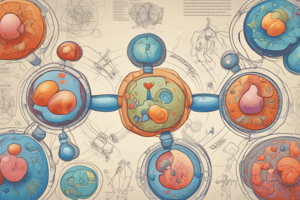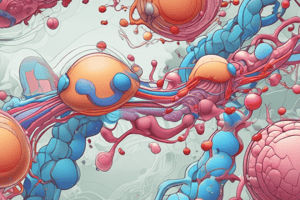Podcast
Questions and Answers
In the fed state, which enzyme is activated by insulin and catalyzes the rate-limiting step of fatty acid synthesis?
In the fed state, which enzyme is activated by insulin and catalyzes the rate-limiting step of fatty acid synthesis?
- NADPH synthase
- Oxaloacetate decarboxylase
- Carnitine transferase
- Acetyl CoA carboxylase (correct)
What is the byproduct of fatty acid synthesis that inhibits the entry of fatty acids into the mitochondrion?
What is the byproduct of fatty acid synthesis that inhibits the entry of fatty acids into the mitochondrion?
- Oxaloacetate
- Acetyl CoA
- Malonyl CoA (correct)
- Citrate
Where does the first step of fatty acid synthesis occur?
Where does the first step of fatty acid synthesis occur?
- Endoplasmic reticulum
- Cytosol (correct)
- Mitochondrion
- Golgi apparatus
What is the primary source of energy storage in the fed state?
What is the primary source of energy storage in the fed state?
What is the coenzyme required for fatty acid synthesis?
What is the coenzyme required for fatty acid synthesis?
What is the primary organ involved in fatty acid synthesis?
What is the primary organ involved in fatty acid synthesis?
What is the purpose of malonyl CoA in fatty acid synthesis?
What is the purpose of malonyl CoA in fatty acid synthesis?
What is the result of insulin stimulation in the fed state?
What is the result of insulin stimulation in the fed state?
What is the role of NADPH in fatty acid synthesis?
What is the role of NADPH in fatty acid synthesis?
Which of the following lipoproteins carries mainly dietary TAG?
Which of the following lipoproteins carries mainly dietary TAG?
What is the rate-limiting step in cholesterol synthesis?
What is the rate-limiting step in cholesterol synthesis?
What is the function of apoproteins in lipoproteins?
What is the function of apoproteins in lipoproteins?
Which of the following is a genetic disorder characterized by high blood cholesterol levels?
Which of the following is a genetic disorder characterized by high blood cholesterol levels?
What is the function of lipoprotein lipase?
What is the function of lipoprotein lipase?
Which of the following is a risk factor for secondary hyperlipoproteinaemias?
Which of the following is a risk factor for secondary hyperlipoproteinaemias?
What is the function of LDL receptors?
What is the function of LDL receptors?
What is the effect of n-6 PUFA on cholesterol levels?
What is the effect of n-6 PUFA on cholesterol levels?
Lp(a) is associated with an increased risk of which disease?
Lp(a) is associated with an increased risk of which disease?
What is the effect of trans fats on Lp(a) levels?
What is the effect of trans fats on Lp(a) levels?
What is the role of plasminogen in relation to Lp(a)?
What is the role of plasminogen in relation to Lp(a)?
What is the main component of foam cells in atherosclerosis?
What is the main component of foam cells in atherosclerosis?
What is the effect of modified (oxidised) LDL on foam cells?
What is the effect of modified (oxidised) LDL on foam cells?
Flashcards are hidden until you start studying
Study Notes
Lipid Synthesis and Transport in the Blood
- Energy from excess food is stored as glycogen (limited store) and triacylglycerol (TAG) in adipose tissue (long-term reserve)
- In the fed state, liver synthesizes TAG from acetyl CoA, stimulated by insulin
Fatty Acid Synthesis
- Acetyl CoA is converted to malonyl CoA, catalyzed by acetyl CoA carboxylase (rate-limiting step)
- Malonyl CoA signifies the fed state and inhibits carnitine transferase, preventing fatty acid oxidation
- NADPH from the hexose monophosphate shunt is required for fatty acid synthesis
TAG Synthesis
- Glycerol phosphate and three fatty acids combine to form TAG
- TAG synthesis occurs in the liver cell, using glycolysis products
Lipoprotein Structure
- Lipids are insoluble in water, so they are transported as a lipid-protein complex (lipoprotein)
- Apoproteins have a structural role, are recognized by receptors, and activate enzymes in lipid metabolism
- Lipoproteins have an inner core of triglycerides and cholesterol esters, surrounded by a single layer of phospholipids, cholesterol, and apoproteins
Classes of Lipoproteins
- Chylomicrons: largest and lowest density, carry mainly dietary TAG
- VLDL: carries mainly endogenous TAG
- LDL: carries mainly cholesterol to the tissues
- HDL: carries mainly cholesterol from the tissues to the liver
Cholesterol Synthesis and Regulation
- Cholesterol synthesis is regulated by negative feedback, controlling its own synthesis and LDL receptors on cell surfaces
- The rate-limiting step is catalyzed by HMG-CoA reductase, inhibited by statins
LDL Receptors
- LDL receptors recognize apoB-100, removing LDL from the circulation through receptor-mediated endocytosis
- Deficiency of LDL receptors leads to high blood cholesterol levels and premature death from atherosclerosis
Hyperlipidaemias
- Hypercholesterolaemia and hypertriglyceridaemia can result from genetic disposition or environmental factors
- Examples of genetic hyperlipoproteinaemias include defective LDL receptor, lipoprotein lipase deficiency, and apoprotein deficiency
Lipoprotein (a)
- Lp(a) is associated with increased risk of CHD, and its levels can be affected by trans fats and oestrogen
- Lp(a) is related to plasminogen and slows down blood clot breakdown
Atherosclerosis
- Atherosclerosis involves inflammation, proliferation of smooth muscle in the artery wall, and accumulation of cholesterol-rich lipid
- Foam cells (macrophages filled with lipid) are a key component of atherosclerotic plaques
Studying That Suits You
Use AI to generate personalized quizzes and flashcards to suit your learning preferences.




